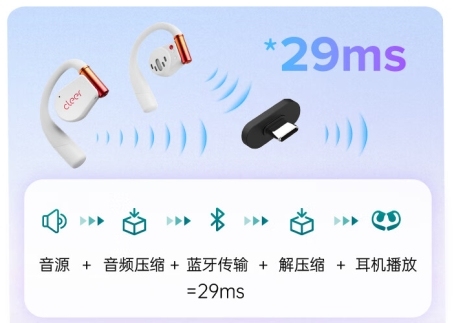2024-06-28 16:33:00
Since Apple first removed the 3.5mm headphone jack on the iPhone 7 in 2017, mobile phone manufacturers have followed suit and the 3.5mm headphone jack has gradually faded out of people's sight. This operation has indirectly promoted the rise of true wireless headphones.
Without the obstruction of cables, listening to music with true wireless headphones is indeed enjoyable, but for those who enjoy playing games, it becomes an indescribable pain because the headphones need to be connected through Bluetooth, and the delay caused by wireless connection greatly reduces the gaming experience. In games, it is important to hear the sound at the first time. If you cannot quickly hear the footsteps or gunshots of enemies and make corresponding actions in a timely manner, it takes minutes to land and form a box.
Although modern Bluetooth technology is quite mature, in some cases, users can still perceive the lack of synchronization between audio and video, which is particularly evident in fast-paced games. So the latency of gaming Bluetooth earphones has become a focus of technological breakthroughs for major manufacturers in recent years.
In this context, the Cleer ARC 3 Sound Arc Open AI Earphone Gaming Edition launched this year has attracted the attention of many professional esports players with its ultra-low latency of 29ms.
Cleer ARC 3 Sound Arc is the world's first open AI earphone launched by the international intelligent acoustics brand Cleer in April 2024. It is divided into multiple versions according to the needs of different usage scenarios, such as music version, sports version, game version, youth version, etc. Among them, the game version is loved by many professional esports players due to its excellent low latency performance and immersive sound experience, and has quickly accumulated high popularity in the esports industry. The top player in the esports industry, Yinuo, has also publicly recommended the low latency performance of this product multiple times.

What is the concept of a latency as low as 29ms?
To answer this question, we first need to understand why Bluetooth earphones have latency? Simply put, the sound emitted from mobile phone speakers and wired headphones can be directly transmitted to our ears, and this type of audio signal is called an analog signal. However, true wireless headphones use Bluetooth wireless connection, usually using digital signals. Digital signals are like "encrypted" audio that needs to be "decrypted" from your phone before being transmitted to your true wireless earphones. At this point, the headphones also need to 'translate' these digital signals into sounds that our human ears can understand. From decoding, encoding, transmission, reception, re decoding, caching, to playback, this process usually requires seven or eight steps of processing. It seems that delays in Bluetooth earphones are inevitable!
In other words, with current audio technology, it is basically impossible for true wireless headphones to achieve zero latency. The only way is to further reduce latency through technological means until it is imperceptible.

According to the evaluation criteria of "Software Green Alliance Game Experience Standard 3.0" (referred to as "Green Label 3.0"):
When the latency of Bluetooth earphones is less than 140ms, the user's gaming experience is not noticeable and the experience is comfortable.
When the delay exceeds 200ms, users will have a noticeable sense of delay and find it difficult to accept.
When the delay was between 140ms and 200ms, the user's sense of delay was not significant and was within an acceptable range.
As the demand for wireless devices continues to grow, players' demanding requirements for audio and visual synchronization are becoming increasingly prominent. Currently, the latency of gaming Bluetooth earphones is generally imperceptible to the human ear as long as it is below 35ms; Delay between 35-50ms, only a few professionals can perceive it; As long as the delay is less than 70ms, there are basically no major problems playing various games. Because the human auditory system's response time to sound is approximately within 100ms, beyond this time, people may feel significant delays.
So the Cleer ARC 3 tone arc, which can control the delay to 29ms, can be said to be an excellent presence in the gaming Bluetooth headphone circle.
How did Cleer ARC 3 Sound Arc Game achieve such low latency technically?
I believe that knowledgeable friends who have looked at the configuration of the Cleer ARC 3 Sound Arc will find that it has really invested a lot of money this time. Not only has the hardware equipment level been fully upgraded, but it has also put a lot of effort into software optimization.
Low latency codec
Cleer ARC 3 supports audio encoding and decoding protocols, including aptX Lossless, LDAC, AAC, and SBC. These codecs can provide optimized audio transmission efficiency and quality under different conditions. LDAC, as an audio encoding technology developed by Sony, can provide low latency while maintaining high sound quality. The amount of data transmitted is about three times that of traditional Bluetooth audio, and the transmission bandwidth is as high as 990kbps. Simply put, it is like a "highway" in wireless protocols, which can transmit more audio data in a short period of time, thereby reducing the delay generated during compression and decompression processes. As one of the closest protocols to lossless decoding, Qualcomm's aptX Lossless has a transmission rate of up to 1.2Mbps, providing high-resolution audio transmission while maintaining low latency.
High performance hardware support
Secondly, the Cleer ARC 3 is equipped with a flagship chip from the Qualcomm S5 series, which integrates the latest audio processing units and optimization algorithms. This chip not only improves audio processing speed but also achieves low-power operation. The powerful computing power of the Qualcomm S5 chip enables headphones to instantly process complex audio signals, reducing processing latency. At the same time, the low-power characteristics of the chip extend the battery life of the headphones, ensuring that players have no worries about long-term gaming. Combined with the latest Bluetooth 5.4 standard, the connection between headphones and devices is more stable, the data transmission rate is greatly improved, and the delay during wireless transmission is further reduced.

Professional gaming dongle accessories
To address the instability and potential latency issues of Bluetooth connections in specific environments, the Cleer ARC 3 Sound Arc is also equipped with a professional gaming dongle accessory specifically for the gaming version. This compact accessory establishes a fast channel between headphones and gaming devices through an optimized wireless transmission protocol, significantly reducing waiting time during signal transmission. By directly plugging into the USB port of a game console or PC, Dongle utilizes proprietary technology to bypass the common Bluetooth pairing process that may cause delays, achieving lower overall system latency.

In short, the Cleer ARC 3 Sound Arc Gaming Edition has taken great care to reduce latency. From low latency codecs, to high-performance chips, and to the assistance of professional gaming dongles, the comprehensive application of these black technologies has enabled the Cleer ARC 3 sound arc to achieve a rare ultra-low latency of 29ms in wireless Bluetooth earphones. If you also want such a low latency, high-performance gaming headset, then Cleer ARC 3 Sound Arc is definitely a good choice, hurry up and get in the car!
Disclaimer: This article is reproduced and published by this website for the purpose of disseminating commercial information, and does not represent the views or positions of this website. All rights and legal responsibilities related to the text, images, audio and video materials mentioned in this article belong to and are borne by the material provider. This website does not guarantee or promise the authenticity of all information, including text, images, etc., nor does it constitute any purchase, investment, or other advice. Therefore, the operator assumes all risks.